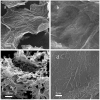Improving Thermo-Oxidative Stability of Nitrile Rubber Composites by Functional Graphene Oxide
- PMID: 29848944
- PMCID: PMC6025397
- DOI: 10.3390/ma11060921
Improving Thermo-Oxidative Stability of Nitrile Rubber Composites by Functional Graphene Oxide
Abstract
Graphene oxide (GO), modified with anti-aging agent p-phenylenediamine (PPD), was added into nitrile rubber (NBR) in order to improve the thermo-oxidative stability of NBR. The modification of GO and the transformation of functional groups were characterized by Fourier transform infrared spectroscopy (FTIR), Raman, and X-ray diffraction (XRD). Mechanical performances of NBR composites before and after the thermo-oxidative aging were recorded. The results of dynamic mechanical analysis (DMA) show an increased storage modulus (G') and a decreased value of area of tan δ peak after introducing modified GO into NBR. It indicates that filler particles show positive interaction with molecular chains. The thermo-oxidative stability of composites was investigated by thermogravimetric analysis (TG) and differential scanning calorimetry (DSC). Then, the thermo-oxidative aging kinetic parameters were obtained by the Flynn⁻Wall⁻Ozawa (FWO) equation. The results of aging tests show that the thermo-oxidative stability of rubber matrix increases obviously after introducing GO⁻PPD. In addition, mechanical properties (tensile strength and elongation at break) of both before and after aged NBR/GO⁻PPD composites were superior to that of NBR. This work provides meaningful guidance for achieving multifunction thermo-oxidative aging resistance rubber composites.
Keywords: graphene oxide (GO); nitrile rubber (NBR); p-phenylenediamine (PPD); thermo-oxidative stability.
Conflict of interest statement
The authors declare no conflict of interest.
Figures












Similar articles
-
Investigation of the Compatibility and Damping Performance of Graphene Oxide Grafted Antioxidant/Nitrile-Butadiene Rubber Composite: Insights from Experiment and Molecular Simulation.Polymers (Basel). 2022 Feb 14;14(4):736. doi: 10.3390/polym14040736. Polymers (Basel). 2022. PMID: 35215649 Free PMC article.
-
Effect of Nitrogen-Doped Graphene Oxide on the Aging Behavior of Nitrile-Butadiene Rubber.Polymers (Basel). 2019 Oct 10;11(10):1637. doi: 10.3390/polym11101637. Polymers (Basel). 2019. PMID: 31658636 Free PMC article.
-
Effect of Graphene Oxide Modified with Organic Amine on the Aging Resistance, Rolling Loss and Wet-skid Resistance of Solution Polymerized Styrene-Butadiene Rubber.Materials (Basel). 2020 Feb 25;13(5):1025. doi: 10.3390/ma13051025. Materials (Basel). 2020. PMID: 32106395 Free PMC article.
-
Aging-Resistant Functionalized LDH⁻SAS/Nitrile-Butadiene Rubber Composites: Preparation and Study of Aging Kinetics/Anti-Aging Mechanism.Materials (Basel). 2018 May 18;11(5):836. doi: 10.3390/ma11050836. Materials (Basel). 2018. PMID: 29783656 Free PMC article.
-
Review on the Conceptual Design of Self-Healable Nitrile Rubber Composites.ACS Omega. 2021 Apr 6;6(15):9975-9981. doi: 10.1021/acsomega.0c05743. eCollection 2021 Apr 20. ACS Omega. 2021. PMID: 34056152 Free PMC article. Review.
Cited by
-
Chitin nanowhiskers from shrimp shell waste as green filler in acrylonitrile-butadiene rubber: Processing and performance properties.Carbohydr Polym. 2020 Oct 1;245:116505. doi: 10.1016/j.carbpol.2020.116505. Epub 2020 Jun 2. Carbohydr Polym. 2020. PMID: 32718616 Free PMC article.
-
Reliability Prediction of Acrylonitrile O-Ring for Nuclear Power Applications Based on Shore Hardness Measurements.Polymers (Basel). 2021 Mar 19;13(6):943. doi: 10.3390/polym13060943. Polymers (Basel). 2021. PMID: 33808625 Free PMC article.
-
Investigation of the Compatibility and Damping Performance of Graphene Oxide Grafted Antioxidant/Nitrile-Butadiene Rubber Composite: Insights from Experiment and Molecular Simulation.Polymers (Basel). 2022 Feb 14;14(4):736. doi: 10.3390/polym14040736. Polymers (Basel). 2022. PMID: 35215649 Free PMC article.
-
Effect of Nitrogen-Doped Graphene Oxide on the Aging Behavior of Nitrile-Butadiene Rubber.Polymers (Basel). 2019 Oct 10;11(10):1637. doi: 10.3390/polym11101637. Polymers (Basel). 2019. PMID: 31658636 Free PMC article.
-
Effect of Graphene Oxide Modified with Organic Amine on the Aging Resistance, Rolling Loss and Wet-skid Resistance of Solution Polymerized Styrene-Butadiene Rubber.Materials (Basel). 2020 Feb 25;13(5):1025. doi: 10.3390/ma13051025. Materials (Basel). 2020. PMID: 32106395 Free PMC article.
References
-
- Romero-Flores M., Becerra-Lucatero L.M., Salmón-Folgueras R., Lopez-Salinas J.L., Bremer-Bremer M.H., Montesinos-Castellanos A. Thermal performance of scrap tire blocks as roof insulator. Energy Build. 2017;149:384–390. doi: 10.1016/j.enbuild.2017.05.038. - DOI
-
- Hwang S.J., Park J.H., Son J.H., Choi J.H., Seo H., Park M., Kim J., Moon G.D., Hyun D.C. Thermal annealing-driven surface sealing of polymeric bowl. Polymer. 2017;135:338–347. doi: 10.1016/j.polymer.2017.11.065. - DOI
-
- Irazu L., Elejabarrieta M.J. A novel hybrid sandwich structure: Viscoelastic and eddy current damping. Mater. Des. 2018;140:460–472. doi: 10.1016/j.matdes.2017.11.070. - DOI
-
- He X., Li T., Shi Z., Wang X., Xue F., Wu Z., Chen Q. Thermo-oxidative aging behavior of nitrile-butadiene rubber/functional LDHs composites. Polym. Degrad. Stabil. 2016;133:219–226. doi: 10.1016/j.polymdegradstab.2016.08.018. - DOI
-
- Akhlaghi S., Gedde U.W., Hedenqvist M.S., Brana M.T.C., Bellander M. Deterioration of acrylonitrile butadiene rubber in rapeseed biodiesel. Polym. Degrad. Stab. 2015;111:211–222. doi: 10.1016/j.polymdegradstab.2014.11.012. - DOI
LinkOut - more resources
Full Text Sources
Other Literature Sources
Miscellaneous

